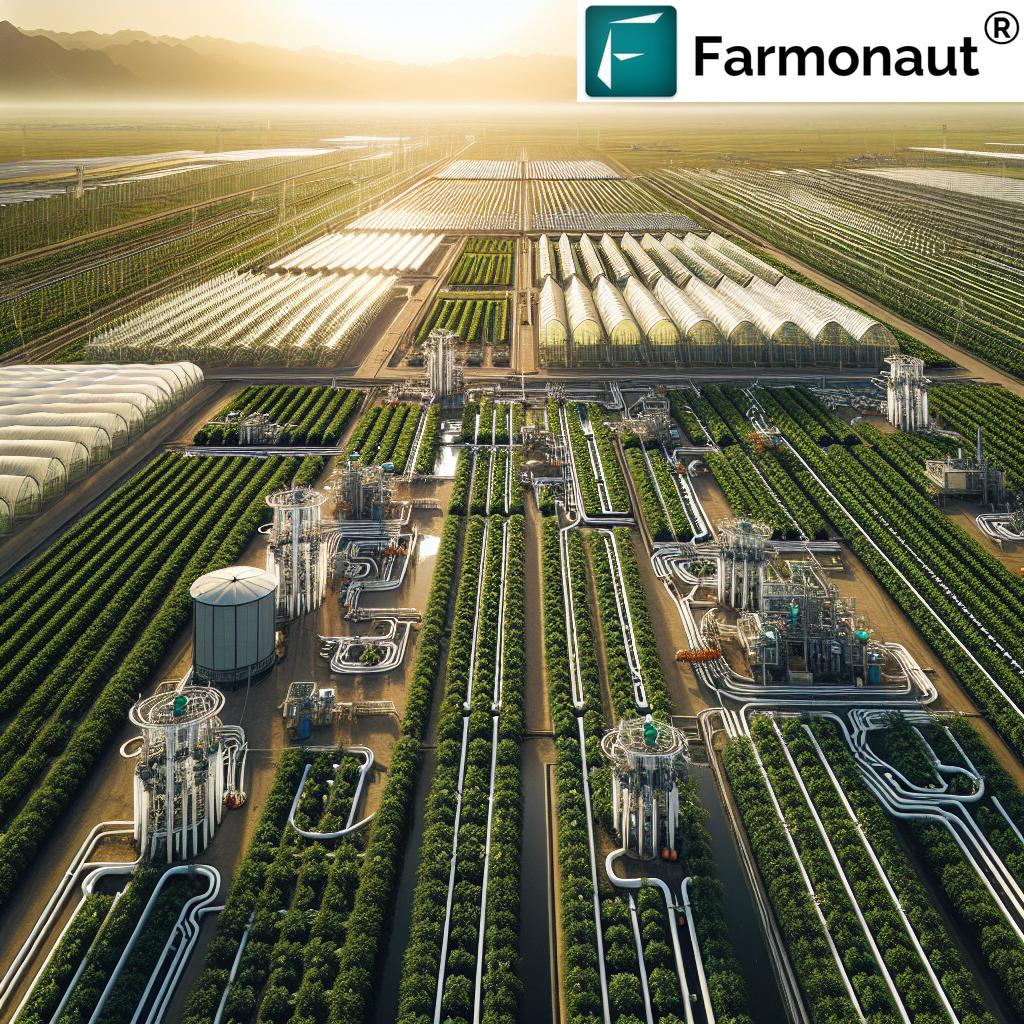Table of Contents
- Introduction
- Define Plantation System: Overview, Evolution, & Advances
- Plantation System in India: Technology, Practices, and Sustainability
- Define Crop Production Management: Strategy, Practices, & Innovations
- Crop Production Management in 2025: Data, Precision, and AI
- Define Green Revolution in India: Impact, Legacy, and Modern Adaptation
- Green Revolution’s Evolution: Sustainability, Diversification, & Future Directions
- Comparison Table: Plantation, Traditional Crop Production, Green Revolution, and Tech-Driven Agriculture (2025)
- Satellite & AI in Future Agriculture: The Role of Farmonaut
- FAQs: Plantation System, Crop Production, Green Revolution in India
- Conclusion: Toward a Resilient, Tech-Powered Agricultural Future
- Farmonaut Subscription and Access
Plantation System, Crop Production Management, and the Green Revolution in India: An Agricultural Perspective for 2025
Agriculture remains a foundational pillar of the Indian economy and the very sustenance of its growing population. As we advance into 2025, the continued evolution of agriculture in India can be traced through three historic yet dynamic domains:
Plantation system, crop production management, and the transformative Green Revolution in India. Understanding these systems—and how they are adapting via technology, innovation, and sustainable practices—is essential not only for policymakers and farmers but for anyone who seeks to appreciate the country’s journey toward food security and environmental health.
This blog explores definitions, the operational mechanisms, technological trends, and the future impact of these paradigms as India meets the challenges and demands of 2025 and beyond.
What is Plantation System? [Define Plantation System: Overview, Evolution, & Advances]
To define plantation system is to trace a historic, organized approach to large-scale agricultural production that continues to influence India’s economy today. The plantation system refers to an agricultural method centered around the expansive, commercial cultivation of a single crop—often called a cash crop—on large estates.
Key Characteristics of the Plantation System in India (2025)
- Single Crop Focus: Typically revolves around crops like tea, coffee, rubber, sugarcane, spices, and oil palms.
- Expansive Estates: Operated on large tracts of land, characterized by significant land ownership, often controlled by private companies or large landowners.
- Commercial Orientation: Unlike subsistence farming, the plantation system is commercial, focused on profits and export.
- Organized Management: Involves systematic planting, maintenance, harvesting, and processing units, often located nearby for efficiency.
- Labor Intensive yet Evolving: Traditionally reliant on large labor forces, but increasingly integrating automation and technological advancements.
- Integration of Technology: As of 2025, precision agriculture, IoT-based monitoring, and automated machinery are transforming traditional plantation operations.
- Environmental Concerns: Challenges include soil degradation, water use inefficiency, and ecological impact, driving the adoption of sustainable practices.
The plantation system differs from subsistence or mixed crop farming in its scale of operation and strong commercial orientation. Estates are usually controlled by those with significant resources—private companies or large landowners. Systematic planting and maintenance protocols are often integrated with processing units for value addition.
Typical Plantation Crops in India
- Tea (Assam, West Bengal, Tamil Nadu, Kerala)
- Coffee (Karnataka, Kerala, Tamil Nadu)
- Rubber (Kerala, Tamil Nadu)
- Sugarcane (Uttar Pradesh, Maharashtra, Karnataka, Tamil Nadu, Andhra Pradesh)
- Spices (Kerala, Karnataka, Tamil Nadu)
- Oil Palms (Andhra Pradesh, Tamil Nadu, Kerala, Karnataka, Goa)
Plantation crops are usually perennial, offering employment throughout the year, but integration of precision tools and data-driven management is actively reducing labor dependency and boosting productivity in 2025.
Plantation System in India: Technology, Practices, and Sustainability in 2025
The plantation system in India is undergoing a technological metamorphosis in 2025. Remote sensing, satellite imagery (see large-scale farm management for plantation advisory benefits), AI-driven monitoring, and automation in harvesting and input application are helping increase yield and production quality while addressing environmental challenges.
Key technological trends transforming Indian plantations:
- Precision Agriculture: Targeted fertilizer and pesticide use based on site-specific data to optimize input efficiency.
- IoT-Enabled Monitoring: Real-time tracking of soil moisture, pests, and crop health.
- Satellite-Based Resource Management: Integration of fleet and resource management tools for operational optimization and logistics.
- Blockchain Traceability: Supply chain transparency with traceability platforms, verifying the source and sustainability of plantation crops.
- Environmental Impact Monitoring: Carbon footprint tracking and emission measurement empower growers to comply with regulations and adopt sustainable practices.
What is Crop Production Management?
[Define Crop Production Management: Strategy, Practices, & Innovations]
To define crop production management is to comprehend the strategic planning, implementation, and control of agricultural practices that optimize crop cultivation for maximum yield and quality. In essence, crop production management integrates scientific, data-driven approaches with hands-on practices, balancing soil fertility, seed selection, crop rotation, irrigation scheduling, pest and disease control, and post-harvest handling.
Core Elements of Crop Production Management
- Soil Fertility Management: Strategic application of fertilizers based on soil testing, organic amendments, and crop requirements.
- Seed Selection: Adoption of high-quality, disease-resistant, and site-suitable seed varieties.
- Crop Rotation / Diversification: Rotating different crops to maintain soil health, reduce pests, and increase resilience.
- Irrigation Scheduling: Smart water management to reduce wastage and maximize water use efficiency—enabled by remote monitoring systems.
- Pest and Disease Control: Integrated Pest Management (IPM), using biocontrols, mechanical, and chemical strategies only as needed.
- Post-Harvest Handling: Effective storage, processing, and transportation to minimize losses and preserve quality.
Effective crop production management balances the inputs—labor, fertilizers, water, and machinery—to increase efficiency and drive sustainability in farming systems. As of 2025, the emergence of data-driven technologies is reshaping how farmers approach every stage of crop production.
Crop Production Management in 2025: Data, Precision, and AI
2025 marks the mainstream adoption of precision and AI-powered crop management in India. Technologies such as remote sensing, satellite imagery, and AI analytics are empowering farmers to increase productivity, reduce input waste, and promote sustainability. Here’s how modernization is reshaping Indian crop management:
- Remote Sensing & Satellite Imagery: Real-time monitoring of crop growth, pest outbreaks, and water stress across small and large farms.
- AI-Based Advisory: Use of risk models from platforms like Farmonaut’s Jeevn AI to guide sowing, fertilization, harvesting, and pest control.
- Site-Specific Nutrient Management: Targeted fertilizer application based on soil maps, reducing chemical runoff and improving soil health.
- Integrated Pest & Disease Control: Early detection of problems, enabling eco-friendly interventions before major outbreaks occur.
- Government Support: Schemes and training programs to help farmers adopt efficient, sustainable, and resilient practices.
By leveraging technologies—precision irrigation, advanced weather forecasting, blockchain traceability (learn more), and sustainability tools—Indian crop production management is stepping confidently into a data-powered era.
Farmonaut leads in integrating satellite imagery, AI, and blockchain for affordable farm monitoring, real-time crop health and soil condition insights, AI-based advisories, and traceability. Our crop & plantation advisory services, available on web, iOS, and Android, help farmers and businesses increase yield, maintain quality, and make data-backed decisions for long-term productivity—all at a fraction of the traditional cost.
What is the Green Revolution in India?
[Define Green Revolution in India: Impact, Legacy, and Modern Adaptation]
To define Green Revolution in India is to recognize a seismic shift in agricultural production, beginning in the 1960s. The Green Revolution refers to the widespread adoption of high-yielding varieties (HYVs) of wheat and rice, expansion of irrigation, and intensive use of fertilizers and pesticides. This movement helped India move from repeated food shortages in the mid-20th century to food self-sufficiency.
Key Features of the Green Revolution in India
- HYV Seeds: Introduction of semi-dwarf, disease-resistant wheat and rice varieties.
- Massive Irrigation Projects: Dams and canals to supply reliable water to farms.
- Increased Inputs: Surge in use of chemical fertilizers and pesticides for maximum yield.
- Mechanization: Rapid spread of tractors, threshers, and harvesters for efficient operations (reduce labor dependency).
- Government Policies: Minimum support prices, extension services, and input subsidies.
The impact was dramatic: wheat output, for example, rose from 12 to 23 million tonnes in less than a decade. This shift not only improved national food security but also accelerated rural income, infrastructure development, and urbanization.
Green Revolution’s Evolution: Sustainability, Diversification, & Future Directions (2025)
While its successes remain core to India’s agricultural story, the Green Revolution also revealed challenges: soil degradation, water scarcity, excessive chemical inputs, and loss of biodiversity. The “Second Green Revolution” or Evergreen Revolution in 2025 focuses on adaptation via:
- Sustainable Agriculture Practices: Organic farming, minimum chemical input reliance, and restoration of soil health.
- Precision Inputs: Using satellite data and AI (like Farmonaut’s advisory platforms) for site-specific fertilizer/water use and early pest identification.
- Crop Diversification: Expanding from predominantly wheat and rice to millets, pulses, and horticulture, aided by government policy and market support.
- Climate Resilience: Adoption of drought-resistant and short-duration crops along with climate-smart farming approaches.
- Smart Irrigation: Micro-irrigation systems and moisture sensors increase efficiency in water-stressed regions.
Thus, the Green Revolution in India continues to influence the pace and direction of farming, even as the sector adapts for environmental, health, economic, and nutritional outcomes.
Comparison of Plantation System, Traditional Crop Production, Green Revolution, and Tech-Driven Agriculture (2025)
| Key Factors | Plantation System | Traditional Crop Production | Green Revolution | 2025’s Tech-Driven Agriculture |
|---|---|---|---|---|
| Farming Approach | Large-scale, single cash crop, commercial, organized by companies/large landowners | Small-holder, mixed/rotational, family subsistence, low mechanization | Medium-large scale, cereal dominant, government-supported mechanization | Data-driven, multispectral/AI monitoring, climate-smart, sustainable |
| Major Crops | Tea, coffee, rubber, spices, sugarcane, oil palm | Pulses, cereals, vegetables, oilseeds | Wheat, rice, maize, HYVs | Wide: Cereals, pulses, millets, oilseeds, perennials, commercial and food crops |
| Technology Use | Medium–High: Mechanization, IoT, remote sensing for resource management | Low: Manual, minimal tool use, local knowledge | Medium: HYV seeds, irrigation, machinery, chemical inputs | High: Satellite, AI, blockchain, IoT, automation, apps, platforms |
| Sustainability | Historically low but improving (sustainable plantation practices) | Natural cycles, but variable efficiencies and vulnerability | Mixed; intensive leads to resource depletion, but improved yields | Prioritized; carbon tracking, soil health, low chemical use |
| Yield per Hectare (estimated) | 3–5 tonnes/ha (depends on crop) | 1–2 tonnes/ha | 3–4 tonnes/ha (wheat/rice) | 4–6 tonnes/ha (optimized conditions) |
| Labor Requirement (estimated) | High to Medium (automation reducing labor needs) | High (manual, family labor-based) | Medium (mechanization, but input-heavy) | Medium to Low (due to automation, robotics, AI) |
| Environmental Impact | Soil degradation, monoculture risks, but improving with sustainability focus | Generally low, but not scalable; inefficiency causes localized stress | Water overuse, chemical runoff, biodiversity loss | Very low impact (carbon monitoring, water use optimization, biodiversity preservation) |
Satellite & AI in Future Agriculture: The Role of Farmonaut
Digital transformation is at the heart of agriculture in 2025. Farmonaut exemplifies how satellite technology, AI, and blockchain are reshaping Indian farming from plantation to field crops:
- Satellite-Based Monitoring: Multispectral data for crop health, soil moisture, and infrastructure integrity at parcel and landscape scale.
- AI Advisory Systems (e.g., Jeevn AI): Actionable, AI-powered insights for farming and resource management.
- Blockchain Traceability: Verifiable, fraud-resistant supply chains for food safety, sustainability, and export compliance.
- Fleet and Resource Management: Automated logistics, equipment monitoring, and cost management for large-scale operations.
- Environmental Impact Monitoring: Carbon footprinting and sustainability indicators drive compliance and market preference.
- Affordability & Scalability: Farmonaut’s subscription model (see below) democratizes high-tech for all farm sizes—scaling from small-holder to government applications.
By embracing innovations like carbon footprinting, traceability, and fleet/resource tools, India is creating a blueprint for resilient, eco-friendly farming systems.
FAQs: Plantation System, Crop Production Management, and Green Revolution in India
What does “define plantation system” mean for Indian agriculture?
Answer: It refers to the organized, large-scale cultivation of single cash crops such as tea, coffee, rubber, or oil palm, typically managed by private companies or large landowners for commercial and export purposes, with a strong focus on systematic planting, harvesting, and processing.
How does crop production management improve farm outcomes in 2025?
Answer: Crop production management uses strategic planning, input balancing, precision technologies, soil monitoring, and integrated pest and disease control to optimize yield, minimize waste, maintain soil health, and support sustainability through advanced data analytics and AI-guided advisories.
How did the Green Revolution in India change agricultural productivity?
Answer: The Green Revolution doubled the yield of core staples like wheat and rice between the 1960s and 1970s, through HYV seeds, subsidized irrigation, and chemical inputs, transforming India from a food deficit to a food self-sufficient nation.
What technological innovations define agriculture in 2025?
Answer: Automated monitoring (satellite imagery, IoT), artificial intelligence-driven advisories, blockchain traceability, fleet/resource management, and real-time environmental impact assessment define the 2025 agricultural landscape, enabling data-driven, sustainable decision-making.
How do Farmonaut’s products support agricultural sustainability?
Answer: By enabling affordable satellite crop monitoring, AI weather/advisory support, supply chain traceability, resource and fleet optimization, and real-time carbon/environmental impact tracking for farmers, agribusinesses, and governments.
Where can I access Farmonaut’s satellite-powered agriculture tools and documentation?
Answer: Try Farmonaut’s web & mobile apps, view API integration info here, and get full API developer documentation for technical use.
Conclusion: Toward a Resilient, Tech-Powered Agricultural Future
From the plantation system through crop production management to the legacy of the Green Revolution in India, the evolution of Indian agriculture is a testament to adaptation, technology, and sustainability. The 2025 landscape is shaped by integration of digital tools and a pivot towards resilience, impacting everything from yield optimization and input efficiency to soil and environmental health.
As technology continues to democratize access via platforms like Farmonaut, growers—small and large—can navigate challenges and harness innovation to secure both livelihoods and ecological responsibility. Together, these approaches mark a dynamic, enduring sector capable of meeting the demands of India’s growing population and changing conditions for years to come.
Farmonaut Subscription and Access
Farmonaut subscriptions are designed for affordability, offering scalable, real-time monitoring solutions with satellite imagery, AI, and blockchain for users of all sizes—from single growers to large organizations and state governments.












